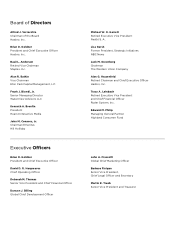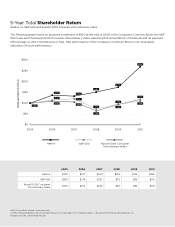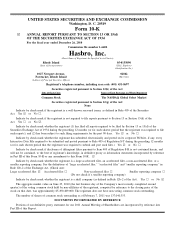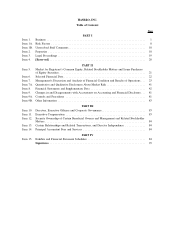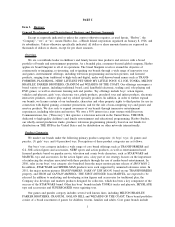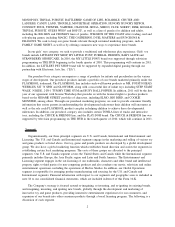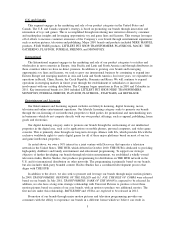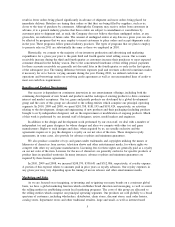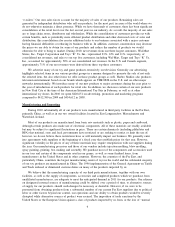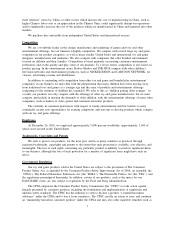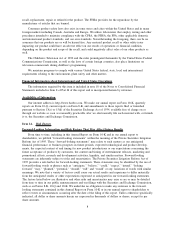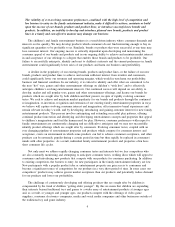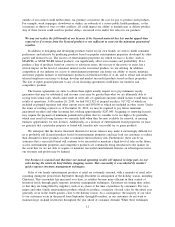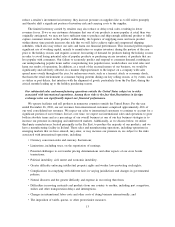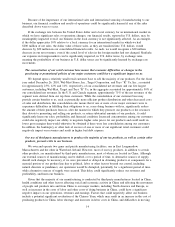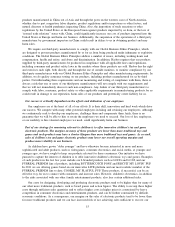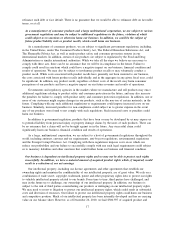Hasbro 2010 Annual Report Download - page 17
Download and view the complete annual report
Please find page 17 of the 2010 Hasbro annual report below. You can navigate through the pages in the report by either clicking on the pages listed below, or by using the keyword search tool below to find specific information within the annual report.
trade relations” status by, China, or other factors which increase the cost of manufacturing in China, such as
higher Chinese labor costs or an appreciation in the Chinese Yuan, could significantly disrupt our operations
and/or significantly increase the cost of the products which are manufactured in China and imported into other
markets.
We purchase dies and molds from independent United States and international sources.
Competition
We are a worldwide leader in the design, manufacture and marketing of games and toys and other
entertainment offerings, but our business is highly competitive. We compete with several large toy and game
companies in our product categories, as well as many smaller United States and international toy and game
designers, manufacturers and marketers. We also compete with companies that offer branded entertainment
focused on children and their families. Competition is based primarily on meeting consumer entertainment
preferences and on the quality and play value of our products. To a lesser extent, competition is also based on
product pricing. In the entertainment arena, Hasbro Studios and THE HUB compete with other children’s
television networks and entertainment producers, such as NICKELODEON and CARTOON NETWORK, for
viewers, advertising revenue and distribution
In addition to contending with competition from other toy and game and branded play entertainment
companies, in our business we must deal with the phenomenon that many children have been moving away
from traditional toys and games at a younger age and the array of products and entertainment offerings
competing for the attention of children has expanded. We refer to this as “children getting older younger.” As
a result, our products not only compete with the offerings of other toy and game manufacturers, but we must
compete, particularly in meeting the demands of older children, with the entertainment offerings of many other
companies, such as makers of video games and consumer electronic products.
The volatility in consumer preferences with respect to family entertainment and low barriers to entry
continually creates new opportunities for existing competitors and start-ups to develop products which compete
with our toy and game offerings.
Employees
At December 26, 2010, we employed approximately 5,800 persons worldwide, approximately 3,100 of
whom were located in the United States.
Trademarks, Copyrights and Patents
We seek to protect our products, for the most part, and in as many countries as practical, through
registered trademarks, copyrights and patents to the extent that such protection is available, cost effective, and
meaningful. The loss of such rights concerning any particular product is unlikely to result in significant harm
to our business, although the loss of such protection for a number of significant items might have such an
effect.
Government Regulation
Our toy and game products sold in the United States are subject to the provisions of The Consumer
Product Safety Act, as amended by the Consumer Product Safety Improvement Act of 2008, (as amended, the
“CPSA”), The Federal Hazardous Substances Act (the “FHSA”), The Flammable Fabrics Act (the “FFA”), and
the regulations promulgated thereunder. In addition, certain of our products, such as the mixes for our
EASY-BAKE ovens, are also subject to regulation by the Food and Drug Administration.
The CPSA empowers the Consumer Product Safety Commission (the “CPSC”) to take action against
hazards presented by consumer products, including the formulation and implementation of regulations and
uniform safety standards. The CPSC has the authority to seek to declare a product “a banned hazardous
substance” under the CPSA and to ban it from commerce. The CPSC can file an action to seize and condemn
an “imminently hazardous consumer product” under the CPSA and may also order equitable remedies such as
7


